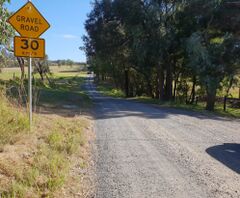Tag:surface=gravel
| Description |
|---|
| This tag has very large meaning range. Used for cases ranging from huge gravel pieces like track ballast used as surface, through small pieces of gravel to compacted surface. |
| Group: properties |
| Used on these elements |
| Status: de facto |
| Tools for this tag |
|
| TODO: incorporate usage analysis and reasoning from https://lists.openstreetmap.org/pipermail/talk-au/2021-March/014445.html and https://lists.openstreetmap.org/pipermail/talk-au/2021-March/014450.html |
This tag has very wide meaning range. Used for cases ranging from huge gravel pieces like track ballast used as surface, through small pieces of gravel to compacted surface.
If you intend to map compacted gravel road (often called "gravel roads" or "dirt roads"), please use surface=compacted instead.
Tag history
For a long time this tag was described at Key:surface page as "Broken/crushed rock with sharp edges, known as ballast on railways. Usually loosely arranged. Typical size for road and surface construction range between 4 and 8 cm".
But "gravel roads" term is often used in many countries for something where far smaller pieces of rock are used, some of such roads would qualify for surface=compacted.
As result surface=gravel may refer to road where track ballast from old railway (or crushed stone similar to track ballast) was used, making it tricky or impassable for regular cars and bicycles.
It may also refer to roads of compacted surface that are unpaved but high quality roads, often allowing comfortable travel.
surface=fine_gravel, surface=rock, surface=pebblestone, surface=compacted are closely related but different surface values.
surface=cobblestone is suffering from very similar problem (solved by establishing more clear surface=sett and surface=unhewn_cobblestone).
Additional Tags
To match the tagging scheme in use for paving stones (surface=paving_stones, proposed in Proposed features/Paving stone details), additional information about the surface can be added with tags like surface:colour=*.
Examples with notes
Case where surface=gravel matches definition that was present at Key:surface for a long time.
External links
- https://lists.openstreetmap.org/pipermail/talk-au/2021-March/thread.html#14434
- Category:Gravel roads at Wikimedia commons demonstrating variety
See also
- surface=compacted (often called "gravel roads" or "dirt roads")
- surface=fine_gravel (for loose / uncompacted fine gravel)
- surface=pebblestone (for rounded / uncrushed stone, often used for decorative purposes)



